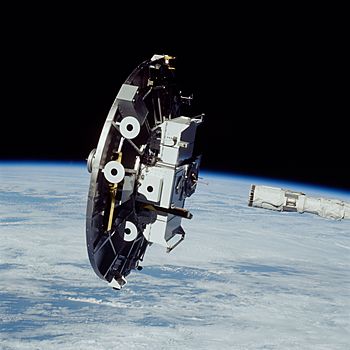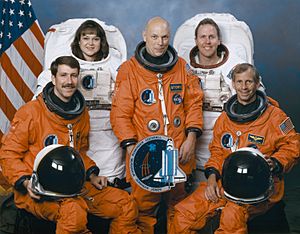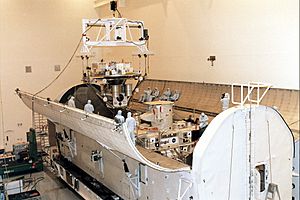STS-80 facts for kids

The Wake Shield Facility takes flight for a third time, after being deployed by Columbia's Canadarm
|
|
| Mission type | Research |
|---|---|
| Operator | NASA |
| Mission duration | 17 days, 15 hours, 53 minutes, 18 seconds |
| Distance travelled | 11,000,000 kilometres (6,800,000 mi) |
| Orbits completed | 279 |
| Spacecraft properties | |
| Spacecraft | Space Shuttle Columbia |
| Payload mass | 13,006 kilograms (28,673 lb) |
| Crew | |
| Crew size | 5 |
| Members |
|
| Start of mission | |
| Launch date | 19 November 1996, 19:55:47 UTC |
| Launch site | Kennedy LC-39B |
| End of mission | |
| Landing date | 7 December 1996, 11:49:05 UTC |
| Landing site | Kennedy SLF (Rwy 33) |
| Orbital parameters | |
| Reference system | Geocentric |
| Regime | Low Earth |
| Perigee | 318 kilometres (198 mi) |
| Apogee | 375 kilometres (233 mi) |
| Inclination | 28.45 degrees |
| Period | 91.5 min |
  Left to right - Seated: Rominger, Cockrell; Standing: Jernigan, Musgrave, Jones |
|
STS-80 was a Space Shuttle mission flown by the Space Shuttle Columbia. It was a very long trip into space! The mission was originally planned for October 1996. However, it was delayed until November 19, 1996. The landing was also delayed by two days because of bad weather.
This mission became the longest Space Shuttle flight ever. It lasted 17 days, 15 hours, and 53 minutes. Even though two spacewalks were planned, they had to be cancelled. This was because of a problem with the airlock hatch. Astronauts Tom Jones and Tammy Jernigan could not leave the orbiter.
Contents
Meet the Crew of STS-80
| Position | Astronaut | |
|---|---|---|
| Commander | Kenneth D. Cockrell Third spaceflight |
|
| Pilot | Kent V. Rominger Second spaceflight |
|
| Mission Specialist 1 | F. Story Musgrave Sixth and last spaceflight |
|
| Mission Specialist 2 | Thomas D. Jones Third spaceflight |
|
| Mission Specialist 3 | Tamara E. Jernigan Fourth spaceflight |
|
During the landing, Story Musgrave stayed on the flight deck. He filmed the spacecraft coming back into Earth's atmosphere. He used the windows above his head to get a great view!
What Happened on the Mission?
- The mission launched two special satellites into space.
- After they finished their jobs, Columbia successfully brought them back.
- The first satellite, ORFEUS-SPAS II, was launched on the first day. It was brought back on day sixteen.
- The second satellite, Wake Shield Facility-3, was launched on day four. It was retrieved three days later.
- This mission holds the record for the longest Space Shuttle flight in history.
- Astronaut Story Musgrave made history on this flight. He became the only person to fly on all five Space Shuttles: Challenger, Atlantis, Discovery, Endeavour, and Columbia.
- Musgrave also tied a record for the most spaceflights. He also set a record for being the oldest man in space at the time. These records have since been broken by other astronauts.
What Did Columbia Carry?
The Space Shuttle Columbia carried two special satellites. Both of these satellites had flown in space before. The mission also carried equipment for two spacewalks that were planned. These spacewalks would have helped prepare for building the International Space Station.
Here are some of the main things Columbia carried:
- Orbiting and Retrievable Far and Extreme Ultraviolet Spectrometer-Shuttle Pallet Satellite II (ORFEUS-SPAS II): This satellite had special telescopes to study light from space.
- Wake Shield Facility (WSF-3): This satellite helped create very pure materials.
- Space Experiment Module (SEM): This module held student science projects.
- EVA Development Flight Tests (EDTF-5): This was equipment to test tools for spacewalks.
- Other experiments: These included studies on plant growth, how blood flows in space, and new ways to manage heat on spacecraft.
Amazing Science Projects
Columbia carried two satellites that were released and later brought back. The first was the Orbiting and Retrievable Far and Extreme Ultraviolet Spectrometer-Shuttle Pallet Satellite II (ORFEUS-SPAS II). This satellite had a powerful telescope called ORFEUS. It used two special tools to look at light from far and extreme ultraviolet parts of the spectrum.
Another tool on the satellite studied gas between stars. The satellite worked perfectly! It made 422 observations of almost 150 different things in space. These ranged from our own moon to stars in other galaxies and even a quasar. This was the second time ORFEUS-SPAS II flew. Because of better equipment, it collected more than twice the data of its first flight.
The Wake-Shield Facility (WSF) was also released from Columbia. This satellite created a super-empty space behind it. This allowed scientists to make very thin layers of special materials called semiconductors. These are used in advanced electronics like computer chips. The WSF made seven of these thin films. Columbia's robotic arm then grabbed it after three days in space. This was the third mission for the 12-foot-diameter (3.7 m) craft. It was designed and built by the University of Houston.
Another important part of the mission was the Space Experiment Module (SEM). This module carried science projects chosen from students! It was the first time this program flew. Some of the experiments studied how bacteria grew on food in space. Others looked at how crystals form or how gravity affects a pendulum.
Other experiments included:
- NIH.R4: This tested how spaceflight affects blood flow.
- Biological Research in Canister (BRIC): This looked at how tobacco and tomato plants grew in space.
- Visualization in an Experimental Water Capillary Pumped Loop (VIEW-CPL): This tested a new way to keep spacecraft cool.
- Commercial MDA ITA Experiment: These were experiments from high school and middle school students.
Getting Ready for Launch
Astronauts for the STS-80 mission were chosen on January 17, 1996. Getting the Space Shuttle ready for launch takes a lot of time and effort! The Solid Rocket Boosters (SRBs) were put together starting September 9, 1996. The launch date was first moved from October 31 to November 8.
Workers had to replace two windows on Columbia. NASA worried they might break after so many flights. Columbia was moved to the Vehicle Assembly Building on October 9 for final preparations. On October 11, Columbia was attached to its large external fuel tank. The payload, which included the satellites and experiments, was also loaded.
The Shuttle was then rolled out to Launch Pad 39B on October 16. After a review on October 28, more checks were needed for the rocket motors. A fuel pump also failed, causing more delays. Bad weather forecasts pushed the launch back even further. Finally, STS-80 launched on November 19, 1996.
Wake-Up Calls in Space
NASA has a fun tradition of playing music to astronauts to wake them up. This started during the Gemini program and was first used on Apollo 15. Each song is chosen carefully, often by the astronauts' families. The songs usually have a special meaning to one of the crew members or relate to what they will be doing that day.
| Flight Day | Song | Artist/Composer |
|---|---|---|
| Day 2 | "I Can See For Miles" | The Who |
| Day 3 | "Theme From Fireball XL5" | Barry Gray |
| Day 4 | "Roll With the Changes" | REO Speedwagon |
| Day 5 | "Reelin' and Rockin'" | Chuck Berry |
| Day 6 | "Roll with It" | Steve Winwood |
| Day 7 | "Good Times Roll" | The Cars |
| Day 8 | "Red Rubber Ball" | Cyrkle |
| Day 9 | "Alice's Restaurant" | Arlo Guthrie |
| Day 10 | "Some Guys Have All the Luck" | Robert Palmer |
| Day 11 | "Changes" | David Bowie |
| Day 12 | "Break on Through (To the Other Side)" | The Doors |
| Day 13 | "Shooting Star" | Bad Company |
| Day 14 | "Stay" | Jackson Browne |
| Day 15 | "Return to Sender" | Elvis Presley |
| Day 16 | "Should I Stay or Should I Go" | The Clash |
| Day 17 | "Nobody Does It Better" | Carly Simon |
| Day 18 | "Please Come Home for Christmas" | Sawyer Brown |






